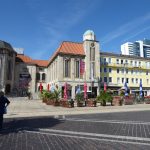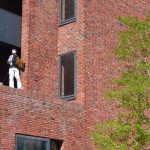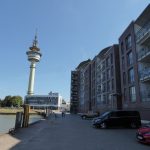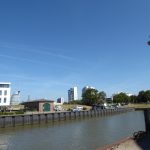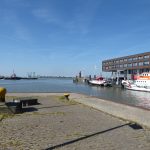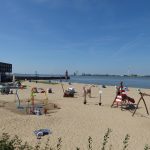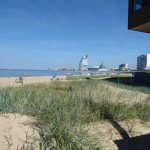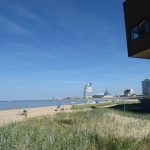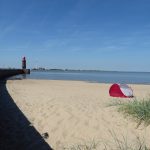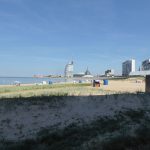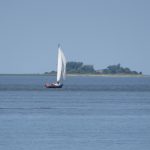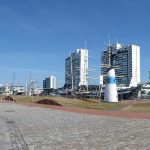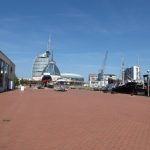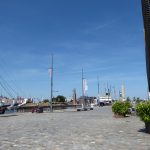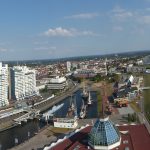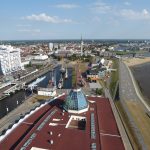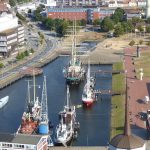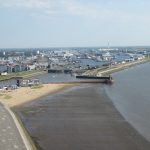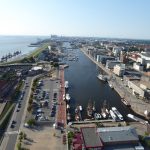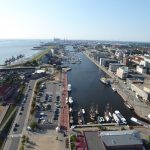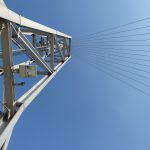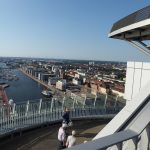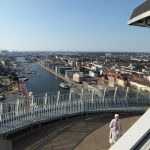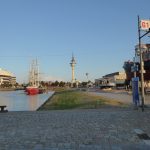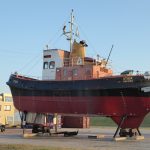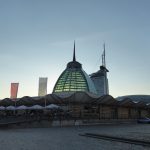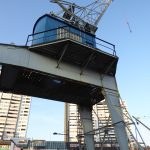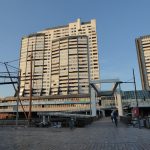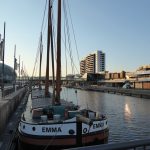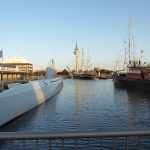New day. Great day. The sun is burning down on Bremerhaven. The asphalt is converting to a liquid. Thankfully, we are inside and most walkways are made from stone. After some coffee, tea and other breakfast essentials, like scrambled eggs, bacon, tomatoes, and Mozzarella, we went out in the scorching heat, walking to the Auswandererhaus.
- Columbus Center
- Submarine and Museum
The Auswandererhaus (14,80 € per adult, senior citizens and children pay less) is a new building right beside the old New Harbor. It is an exhibition and museum reflecting on the emigration from Germany to mainly the USA, but also South America, Canada and Australia. Instead of an old style museum with a ton of artifacts, this museum tries to give you the impression of being an emigrant. Of course you have to immerse yourself in the role, in case you reject it, it might be an unpleasant experience and feel like visit to the wings of a play.
At entry you get a ticket including an image and the name of two persons. One emigrated from Germany the other immigrated to Germany. In addition, you get a small NFC card which can be applied at different locations to a sensor activating audio, video and interactive material.
The course through the museum starts with a short introduction in waiting room, styled like the third class waiting area of the emigration area. Then you enter room presenting the scenery at a pier. To your right the black ships body with small portholes four meter above the pier. The pier itself is full of people and crates. Between the figures depicting people from different epochs embarking on the journey to America, sensors were placed which can be triggered with your visiting card playing soundbites from letters of emigrants. This clever trick ensures that visitors and emigrants blend in and form one crowd at the pier. In case you play your role, you can actually feel how it might have felt to embark on a journey of no return.
The next room is less dark and you can learn about the back story of the emigrants, including your emigrant. They are from different background, age, education, and even nationality. They fled from Germany, Poland and many other European country, because there was no hope, they had no economic perspective, they had no jobs, no money, no food. Feudalistic structures in society forced them out. So they left in the hope to be able to have a life. In short they were economic refugees, political refugees and refugees from war. People like those we let drown in the Mediterranean Sea. Just that we look at them in numbers and not in persons, which makes it easier to turn away. Therefore, I recommend visiting this place it might change your perspective.
To reach the next room you walk up a gangway into the ship itself, meaning you see the entering scene now from above. You can take a last look back onto the harbor and then enter the ship. Upstairs, they modeled typical interiors of the ships used to transport immigrants to the US. Starting with sailing ships, which had tight cabins with low ceilings and bunk beds crowded with people for weeks. In storms water could enter the lower decks and panic broke out. Later, steam ships reduced the travel time from weeks to days, and wooden bunk beds were replaced by metal one. Still being enclosed in a metal body with hundreds of people, some sick some dying must have been a depressing experience. In contrast, the joy of the emigrants must have been great when they saw the shores of New York after days or weeks at sea.
After ‘your arrival’, your can investigate, post arrival stories of those refugees before you enter the second part of the exhibition, reflecting on immigrants to Germany.
The immigration part is mainly styled in flavor of the 1950s and 1960s. The time period were Germany had its large after the war migration phase. The time, we discovered pizza and ruined our shirts with spaghetti. The time, we discovered that ice cream is delicious and can be much more then just a scoop of ice. Later we learned about Döner, Fallafel, Gyros, the “Aunt Emma” shops, we lost to the supermarket, were reopened now by “Uncle Achmed” with new foods. While all this happened, new immigrants worked in our factories, stores and shops supporting growth and wealth of our country. Just like the emigrants in the US did.
A nice goody in the museum is that you can research of family relatives emigrated from Bremerhaven or and other European harbor.
After a couple of hours in the museum, we chilled out and prepared ourselves for the next day.

